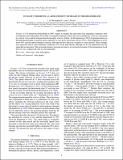VOYAGER 2 OBSERVES A LARGE DENSITY INCREASE IN THE HELIOSHEATH
Author(s)
Wang, C.; Richardson, John D.
DownloadRichardson-2012-VOYAGER 2 OBSERVES A.pdf (796.3Kb)
PUBLISHER_POLICY
Publisher Policy
Article is made available in accordance with the publisher's policy and may be subject to US copyright law. Please refer to the publisher's site for terms of use.
Terms of use
Metadata
Show full item recordAbstract
Voyager 2 (V2) entered the heliosheath in 2007 August at roughly the same time solar minimum conditions were reaching the outer heliosphere. Soon after crossing the termination shock the solar wind density at Voyager decreased by a factor of two and the temperature decreased by a factor of three. At the beginning of 2011 the plasma density in the heliosheath began to increase and in mid-2012 it was up by more than a factor of two. The temperature rose by about 50% and the speed remained constant, although the flow direction continues to turn tailward. These changes may signal the end of solar minimum conditions at V2 in the heliosheath, although we do not understand why the speed did not decrease. The increased dynamic pressure has lead to an outward movement of the termination shock from its very compressed state at solar minimum.
Date issued
2012-10Department
MIT Kavli Institute for Astrophysics and Space ResearchJournal
The Astrophysical Journal. Letters
Publisher
IOP Publishing
Citation
Richardson, J. D., and C. Wang. “VOYAGER 2 OBSERVES A LARGE DENSITY INCREASE IN THE HELIOSHEATH.” The Astrophysical Journal 759, no. 1 (October 16, 2012): L19. © 2012 The American Astronomical Society
Version: Final published version
ISSN
2041-8205
2041-8213